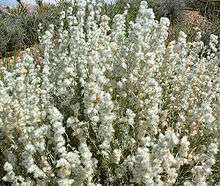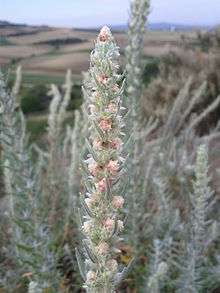Krascheninnikovia
Krascheninnikovia is a genus of flowering plants in the subfamily Chenopodioideae of the family Amaranthaceae known as winterfat, so-called because it is a nutritious livestock forage.[1] They are known from Eurasia and western North America. These are hairy perennials or small shrubs which may be monoecious or dioecious. They bear spike inflorescences of woolly flowers.
| Krascheninnikovia | |
|---|---|
 | |
| Krascheninnikovia lanata | |
| Scientific classification | |
| Kingdom: | Plantae |
| Clade: | Tracheophytes |
| Clade: | Angiosperms |
| Clade: | Eudicots |
| Order: | Caryophyllales |
| Family: | Amaranthaceae |
| Subfamily: | Chenopodioideae |
| Tribe: | Axyrideae |
| Genus: | Krascheninnikovia Güldenstädt |
| Species | |
|
About 7, see text | |
| Synonyms | |
| |
Description
The species of Krascheninnikovia are erect subshrubs or shrubs. The plants are densely covered with dendroid stellate hairs and additionally with simple, unbranched hairs. The alternate leaves stand solitary or grouped in fascicles, and can be petiolate or nearly sessile. The flat, non-fleshy leaf blades are linear to narrowly lanceolate to ovate, with entire margins, and truncate, cuneate, rounded, or subcordate base.[2][3][4]
The flowers are unisexual, the plants can be monoecious or dioecious. Male flowers form an interrupted spike or subcapitate inflorescence of glomeruled, ebracteate flowers. These consist of 4 basally connate perianth segments, that are ovate or elliptic, membranous and abaxially hairy; and 4 stamens with oblong anthers and linear, exserted filaments. Female flowers sitting single or paired axillary, enclosed by 2 hairy bracteoles, that are connate in the lower part, compressed to slightly keeled, with 4 hornlike tips; a perianth is missing, the female flowers consist just of an ovary with a short style and 2 elongated stigmas.[2][3][4]
The hairy fruit enclosed by the bracteoles is ovate and compressed, its membranous pericarp is free from the seed. The vertically orientated seed has a brown thin seed coat covered with white hairs. The embryo is nearly annular or horseshoe-shaped and encloses the copious perisperm.[2][3][4]
The chromosome base number is x=9, for example 2n=36 for Krascheninnikovia ceratoides,[5] 2n=18 and 2n=36 for Krascheninnikovia lanata.
Distribution
The species of Krascheninnikovia are mostly distributed in Eurasia,[3][4] two species occur in North America.[2] In Europe, Krascheninnikovia ceratoides is the only species, it is native in eastern and Southern Europe[6], Winterfat occurs in dry valley bottoms, on flat mesas, and on hillsides, at elevations between 2,400 and 9,300 feet. It is drought resistant and intolerant of flooding, excess water, or acidic soils.Seed production especially in desert regions, is dependent on precipitation. Good seed years occur when there is appreciable summer precipitation and little browsing. Winterfat occurs on well-drained, calcareous soils with low to moderate salt concentrations[7].
Systematics
Krascheninnikovia has been first described in 1772 by Johann Anton Güldenstädt (in: Novi Commentarii Academiae Scientiarum Imperalis Petropolitanae, 16, p. 551). The genus was named for the Russian botanist and explorer of Siberia and Kamchatka, Stepan Krasheninnikov. The type species is Krascheninnikovia ceratoides (L.) Gueldenst.[5] The older name Ceratoides had to be rejected: it referred just to a pre-Linnaeus description by Joseph Pitton de Tournefort, comprising the type of the related genus Ceratocarpus.[3]
The genus Krascheninnikovia belongs to the subfamily Chenopodioideae of the family Amaranthaceae. After phylogenetic research, it was grouped into the tribe Axyrideae.[8]
The genus includes about (3[9]) 7 species:[3][10]
- Krascheninnikovia arborescens (Losinsk.) Czerep.: in China
- Krascheninnikovia ceratoides (L.) Gueldenst. (including Krascheninnikovia lenensis (Kumin.) Tzvelev):[6] from Europe to East Asia
- Krascheninnikovia compacta (Losinsk.) Grubov: in China and Tajikistan
- Krascheninnikovia ewersmannia (Stschegl. ex Losinsk.) Grubov: from Kazakhstan to China (Xinjiang)
- Krascheninnikovia fruticulosa (Pazij.) Czerep.: in Asia
- Krascheninnikovia lanata (Pursh) A.Meeuse & A.Smit: in North America
- Krascheninnikovia pungens (Popov) Czerep.: in Asia
References
- "This native grassland shrub is a protein-rich forage for cattle". Canadian Cattlemen. 2015-04-30. Retrieved 2018-07-16.
- Noel H. Holmgren: Krascheninnikovia - online In: Flora of North America Editorial Committee (Ed.): Flora of North America North of Mexico. Volume 4: Magnoliophyta: Caryophyllidae, part 1. Oxford University Press, New York 2003, ISBN 0-19-517389-9.
- Gelin Zhu, Sergei L. Mosyakin & Steven E. Clemants: Krascheninnikovia - online. In: Wu Zhengyi, Peter H. Raven, Deyuan Hong (Ed.): Flora of China. Volume 5: Ulmaceae through Basellaceae. Science Press/Missouri Botanical Garden Press, Beijing/St. Louis 2003, ISBN 1-930723-27-X.
- Krascheninnikovia - online. In: Helmut Freitag et al.: Chenopodiaceae. In: Flora of Pakistan, Volume 204 - Missouri Botanical Garden Press & University of Karachi.
- Krascheninnikovia at Tropicos, accessed 2013-07-15
- Pertti Uotila, 2011: Chenopodiaceae (pro parte majore): Krascheninnikovia – In: Euro+Med Plantbase - the information resource for Euro-Mediterranean plant diversity, accessed 2013-07-15
- "Winterfat". extension.usu.edu. Retrieved 2020-07-22.
- Gudrun Kadereit, Evgeny V. Mavrodiev, Elizabeth H. Zacharias & Alexander P. Sukhorukov (2010): Molecular phylogeny of Atripliceae (Chenopodioideae, Chenopodiaceae): Implications for systematics, biogeography, flower and fruit evolution, and the origin of C4 Photosynthesis, In: American Journal of Botany, Volume 97 (10), p. 1664-1687.
- Krascheninnikovia at Germplasm Resources Information Network - (GRIN) Online Database Archived 2014-09-13 at the Wayback Machine, accessed 2013-07-15
- Krascheninnikovia at The Plant List, accessed 2013-07-15
External links
| Wikimedia Commons has media related to Krascheninnikovia. |
| Wikispecies has information related to Krascheninnikovia |
